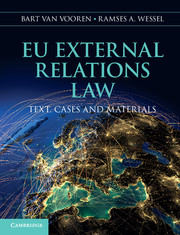Book contents
- Frontmatter
- Contents
- Table of cases
- Table of instruments and legislation
- Preface
- Acknowledgements
- List of abbreviations
- 1 The EU as a global legal actor
- 2 Instruments of EU external action
- 3 Existence of EU external competence
- 4 Nature of EU external competence
- 5 Scope and choice of EU external competence
- 6 The duty of cooperation
- 7 EU law and international law
- 8 The EU and international institutions
- 9 Common Commercial Policy
- 10 EU development policy
- 11 Common Foreign and Security Policy
- 12 Common Security and Defence Policy
- 13 The external dimension of the internal energy market
- 14 The external dimension of freedom, security and justice
- 15 The EU and its neighbours
- Index
- References
2 - Instruments of EU external action
- Frontmatter
- Contents
- Table of cases
- Table of instruments and legislation
- Preface
- Acknowledgements
- List of abbreviations
- 1 The EU as a global legal actor
- 2 Instruments of EU external action
- 3 Existence of EU external competence
- 4 Nature of EU external competence
- 5 Scope and choice of EU external competence
- 6 The duty of cooperation
- 7 EU law and international law
- 8 The EU and international institutions
- 9 Common Commercial Policy
- 10 EU development policy
- 11 Common Foreign and Security Policy
- 12 Common Security and Defence Policy
- 13 The external dimension of the internal energy market
- 14 The external dimension of freedom, security and justice
- 15 The EU and its neighbours
- Index
- References
Summary
Central issues
In this chapter we analyse the instruments through which the EU conducts its external relations. We distinguish between instruments that are adopted within the EU legal order (internal) and those adopted by the Union in the international order (international). These may be instruments adopted by the EU alone (autonomous instruments) or the result of agreements between the Union and a counter-party (conventionally agreed instruments). These instruments can then be legally binding (hard law) or they may be committing in other more indirect or political ways (soft law).
International agreements are the EU’s legal external relations tools par excellence. They form the key legal instrument to allow the Union to play along in the global legal order and to establish legal relationships with third states and other international organizations. If the EU lacked the competence to conclude international agreements, its external relations would be the object of study of political scientists and international relations experts only, and not so much of lawyers. The main part of this chapter will therefore be devoted to the conclusion and variety of international agreements (including mixed agreements, association agreements (AAs) and agreements to accede or withdraw);
- Type
- Chapter
- Information
- EU External Relations LawText, Cases and Materials, pp. 34 - 73Publisher: Cambridge University PressPrint publication year: 2014



